Friday, 9 September 2022
My Spiritual Journeys
Monday, 10 April 2017
The Dancing Gods of Thayyem
Hinduism is based on the idea of all pervading universal consciousness known as Brahman, which has no beginning or end. Thus, mountains, trees, animals, birds and humans, everything animate or inanimate are the expression of Brahman and indicate a unity of all life forms.
In Hinduism, this idea of Brahman is coupled with Gods, one deity for each of the millions of life forms. In Theyyam, the dancer asks a God to come and become manifest in his body. Thus, during the dance-ritual, the dancer becomes an expression of God.
In other parts of India, there are persons who can go into trance and become "a channel of God" to speak and interact with people. For example, in north India they call it "Devi aayi hai" or the "Goddess has come". However, in Theyyam the invocation of God in human body is formalised and accompanied by specific costumes and rituals.
Theyyam is widespread in northern parts of Kerala state, especially around the town of Kannur. Each village and temple has its own Theyyam based a specific God or Goddess or local hero.
There are about 450 kinds of Theyyams. Each Theyyam has its own day during the year when its function will be organised in the village. Theyyam dancers are only men, usually from Hindu lower castes. Only one kind of Theyyam dancers are women.
Theyyam Preparation and Ritual
Around three weeks before the Theyyam celebration, the dancers start a period of abstinence to purify their bodies and minds. One day before Theyyam, they carry out a special invocation prayer called Thattam.
On the day of Theyyam, the dancer prepares his make-up using natural colours. During the make-up, their faces will carry complex designs for their specific Theyyam God and they will wear the ritual dress which is created and maintained by the dancer's family. The facial make-up for each Theyyam is also known as "Face-writing". The costumes include an elaborate head-dress and a breast-plate.
After completing the make-up and putting on the costume, the Theyyam dancer is shown his face in a mirror. This ritual is called Mukhadarshanam. It completes the arrival of God in his body. From that moment he ceases to be seen as human and becomes the manifestation of a specific God or Goddess.
Challenges Facing the Theyyam Traditions
Usually Theyyam dancers do it as a part of their family tradition and there is no or little income from it. With increasing modernisation, urbanisation and technology, it is becoming difficult for individuals to maintain complex social traditions like that of Theyyam, even if it has deep roots in the myths and cultures of the local societies.
Traditions like Theyyam are also under attack because some persons look at them as superstitions, or old fashioned backward rituals. They ignore its social roots and relevance, and look at it in isolation.
Theyyam plays a social role in the complex hierarchy of castes among Hindus. For example, in an interview, a Theyyam dancer said that though socially he belongs to a lower caste, when he becomes Theyyam, persons of all castes including Brahmins and upper caste persons must bend before him and ask for his blessing.
Theyyam Face Make-up in Kochi Folk-lore Museum
The Folk-lore Museum of Kochi has a collection of wooden heads illustrating the different "Face-Writing" designs made for different Gods and personas used in Theyyam. One of these is shown below.
Theyyam ritual dances are organised in villages in north Kerala during winter - especially between October to April. There is a weekly calendar of Theyyam events happening in different villages around the city of Kannur. You can find out it from different websites - here are two examples - TheyyamCalendar and KannurTravel.
Thus, if you want to observe a Theyyam ritual dance in its local village context, check the calendar and plan your visit to Kannur.
Conclusions
I have only seen Theyyam as a part of cultural programmes, as street art and as museum artifacts. I have used the images from those different encounters with Theyyam in this post. However, I hope one day to visit Kannur and see it as part of the local spiritual-religious tradition.
***
PS: In 2018, I had visited Kunoor and visited the sacred ceremonies of Theyyam in 2 villages. I was accompnaied by a local guide. It was an unforgettable experience, not just for the beautiful and exotic costmes and dances, but for its spirituality.
Tuesday, 30 August 2016
A Prayer For India
This photo-essay is about inter-mixing and co-living of religions in India. It has twenty of my favourite images related to religions from different parts of India.
Let me start with an image - it has a Sadhu, a saffron wearing ascetic. Sadhus wander from place to place, are not bound by caste boundaries and live on alms. A sadhu represents the ancient Indic tradition of spirituality, a personal search for a deeper meaning of life. This picture was clicked at Kamakhaya temple in Guwahati (Assam) in the north-east of India.
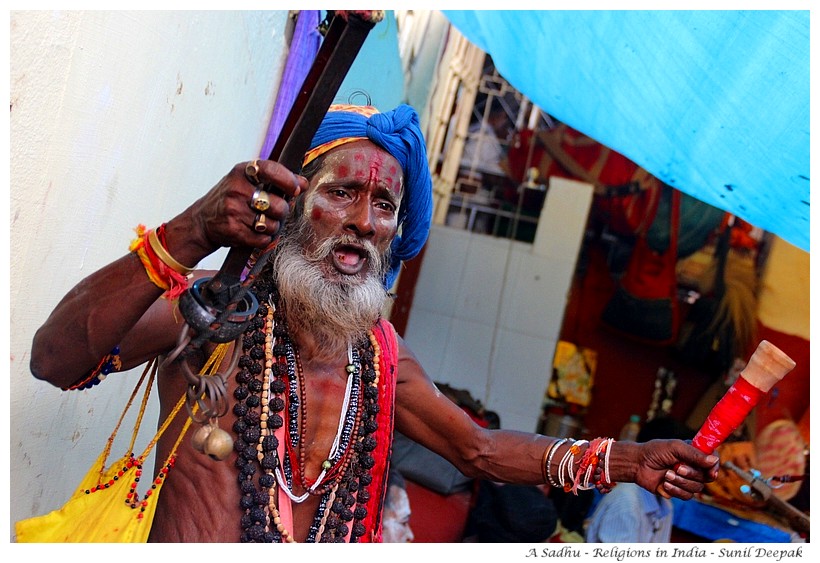
My religious views have been shaped by my growing up in India, where I was exposed to different religions since childhood. My second image represents the two religions which are important in my family today and it is from Kerala at the southern tip of India. It was clicked in a transport van, and has the icons of Madonna and Ganesh on the dashboard.
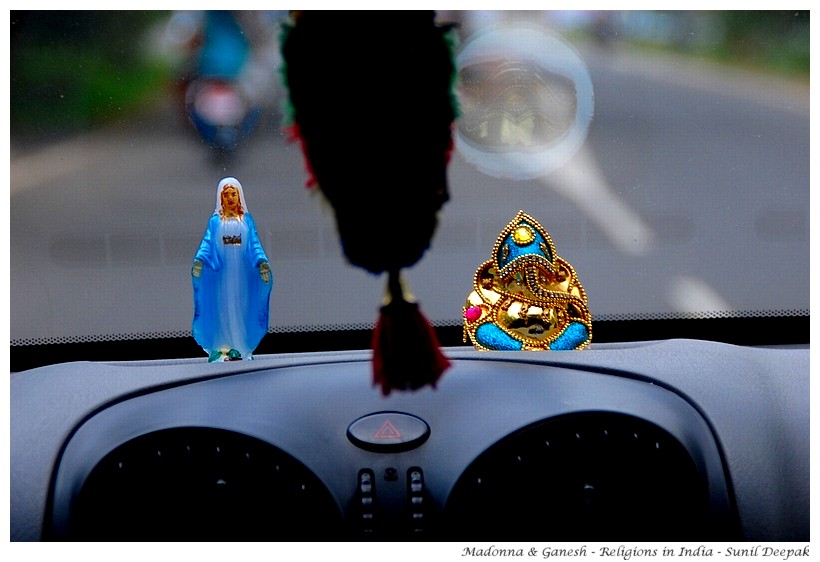
When I was a child, we moved from one rented house to another. For a time, we lived in a predominantly Muslim area, right in front of a Muslim graveyard. Watching the families visiting the graveyard, dressed in all their fineries during Idd festivals, was one of my favourite past times.
It was the time when in my mind, women wearing black burkas were associated with romantic Bollywood films like ‘Chaudhawi ka Chaand’ and ‘Mere Mehboob’, where Hindu heroes thought nothing of masquerading like elderly Muslim ustaad ji and singing shero-shaiyiri, so that they could enter as teachers in the homes of their beloveds.
In another house, which we shared with our Sikh landlord’s family, our terrace overlooked a Methodist church. All the children, including the Pastor’s son, played together. We woke up early in the morning to drink Kacchi lassi on the days of Gurupurab (Sikh religious festivals) and I became familiar with recitations of their sacred book Guru Granth Saheb.
While I was a little afraid of the stern looking wife of the Pastor, I had no problems devouring her Easter cakes. The pastor’s son and the Sikh boys, they all joined me at Holi in throwing balloons full of coloured water on the unsuspecting persons walking on the road below our house.
In yet another house, our next door neighbours were Muslims. While our families were friends, we children played together and shared Idd and Diwali sweets, I never went to a mosque to do prayers with them. Muslim prayers required a complex mix of specific gestures and words which intimidated me. On the other hand, I did go once to a midnight Christmas mass with a Catholic friend.
This pattern of co-living and inter-mixing with persons of different religions has continued all through my life. It has made me understand that religions and beliefs are accidents, determined by our birth in a family and they are not superior or inferior, they are just different ways of approaching the human need for sacred.
The third image is of a roadside shop from Tezpur in Assam, selling pictures of religious icons. The shop was located close to the cathedral and a Hanuman temple, and thus had both Hindu and Christian icons, along with those of other national figures such as Mahatma Gandhi.
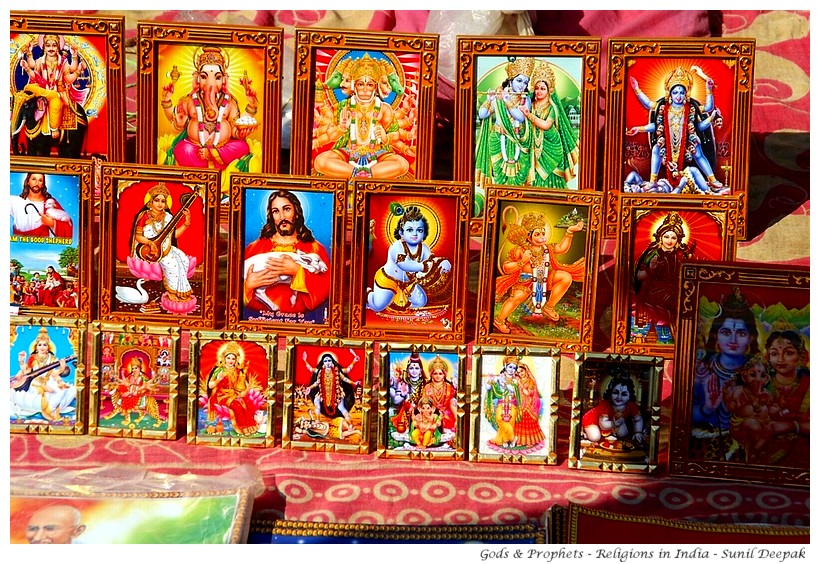
The search for the divine in India is like a tree with roots that go deep into the earth, and with branches going in different directions, pointing to different corners of the sky. Thus, an important part of the sacredness in India is about nature – about the rivers, ponds, trees, animals, birds and the earth.
My fourth image is from Bilaspur district in Chattisgarh in central part of India and has a simple Hindu temple in the middle of a pond. Through sacred ponds and rivers and through rituals like surya namaskar, Indic religions remind me all the time about sacredness of nature.
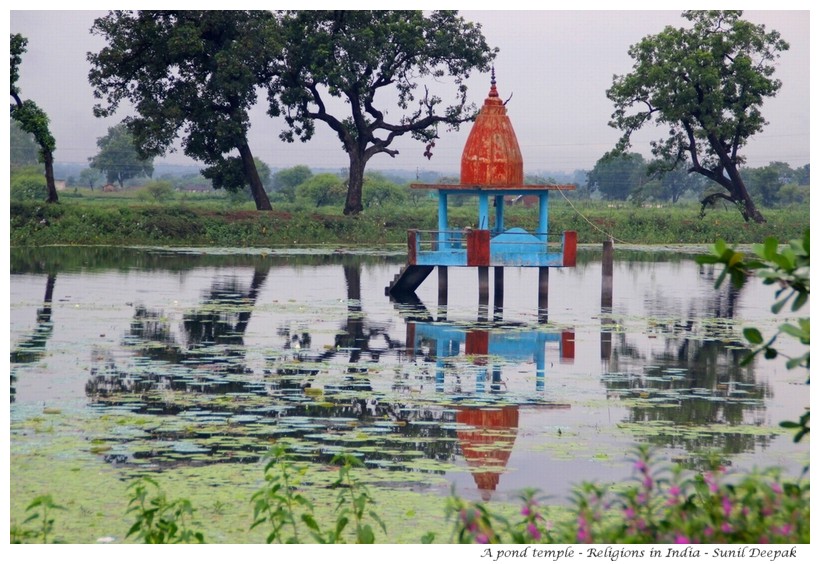
The next three pictures illustrate three streams of Hinduism. The first is from Karnataka, showing a procession when the deities are carried out of the temple to visit the village, accompanied by characters from the sacred epics of Ramayana, Mahabharata and Bhagwat Puran, which are widely known and even today continue to influence Indian society.
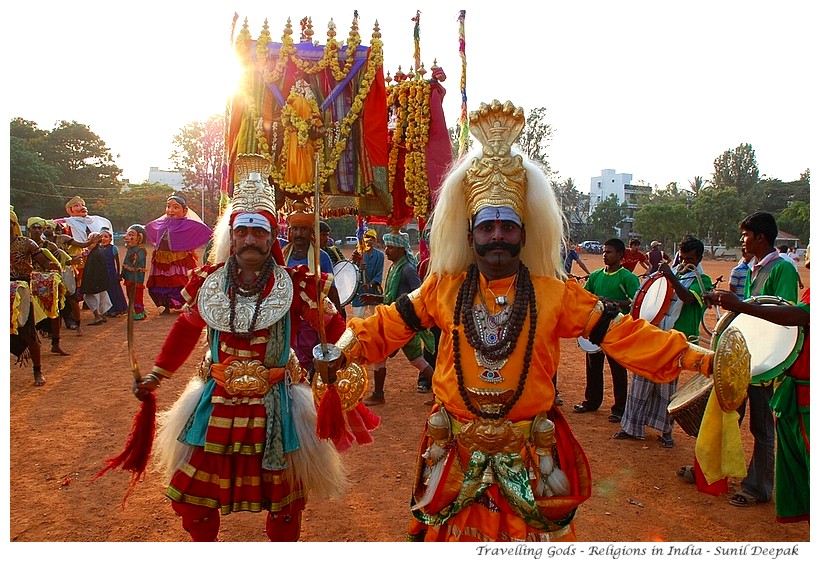
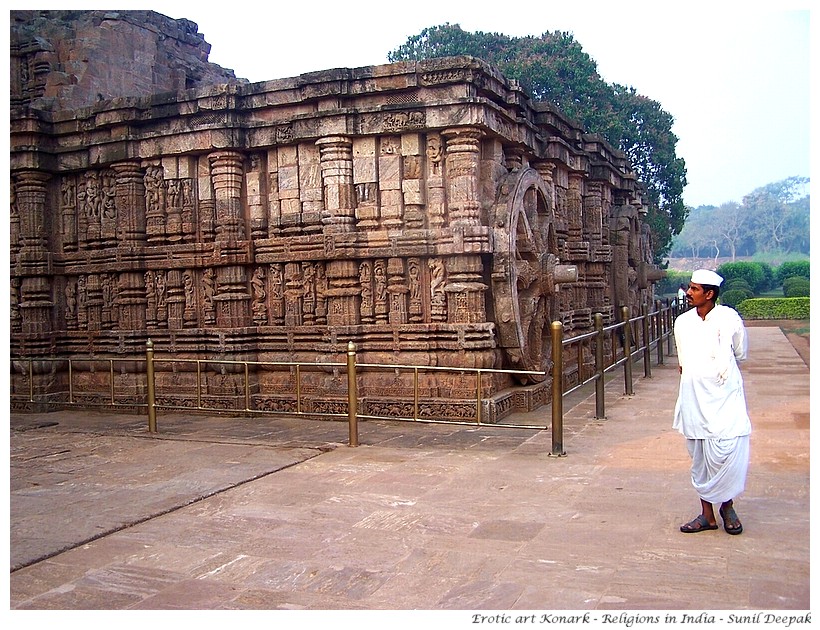
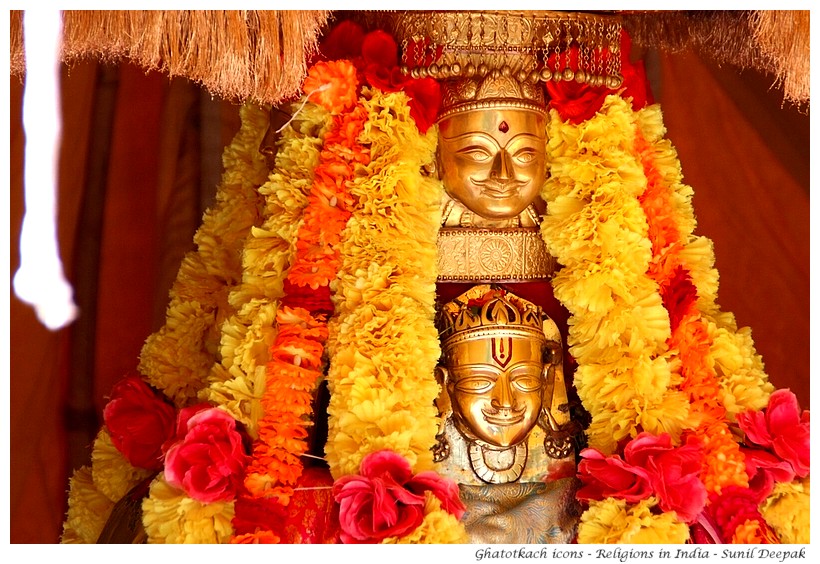
Often outsiders, when they read Indic epics and myths, think of these figures as “villains”, similar to the figures of devil or Satan. However, Indic way of thinking looks at them in more complex ways, recognising their positive attributes and often linking their stories to their different reincarnations. For example, during the enactments of Ramayan during the festival of Dusshera, people are sometimes surprised when they discover the Brahmins praying to the effigy of Ravan before it is burned.
Often while talking to friends from western countries, I feel that they look at Hinduism in a narrow way, focusing on a few figures such as those of the sacred Trimurti (Brahma, Vishnu and Shiva) and the sub-divisions of people into castes according to the Varna system. They ignore the thousand streams of Hinduism and their traditions of debate and arguments. They also tend to believe that the only social reforms and movements for greater social justice towards the marginalised Hindu caste groups in India came from the colonial powers and outsiders.
In a different way, some of the more shrill, conservative or radical Hindu groups echo similar kinds of thinking. They are afraid of the diversity of religious ideas of different streams of Hinduism. They ask repeatedly of following the examples of Abrahamic religions with one sacred book, one religious story and one religious leader.
Indic reformers and other Indic religions
Two millenniums ago, social and religious reformers like Gautam Buddha and Bhagwan Mahavir, infused new ideas in the Indic religions. Over the past centuries, other reformers like Basvanappa, Akka Mahadevi, Shrimanta Shankar Dev, Chetanya Mahaprabhu, Meerabai, Sant Gyaneshwar, Sant Ravidas, Baba Nanak and Sant Kabir, have promoted a diversity of religious ideas touching on social harmony and justice in the Indic religions. This movement of social reform continues through more recent spiritual gurus including Swami Vivekanand and Dayanand Saraswati.
Some of these Indic spiritual figures and social reformers are considered as prophets of specific religions including Buddhism, Jainism and Sikhism. Western way of thinking believes in categorising and emphasising the differences between religions and sects. Indic view of religions, because of the dynamic nature of inter-mixing between them, tends to look at them as different streams flowing in the same direction.
The next six images are about these Indic spiritual and social reformers. The first image is from a street in Gangtok in Sikkim in Himalaya mountains of a Sleeping Buddha and a Buddhist monk. Buddhism continues to be an important religious force in India, especially through its adoption by Dalit caste groups, who see in it as an escape from the caste-oppression.
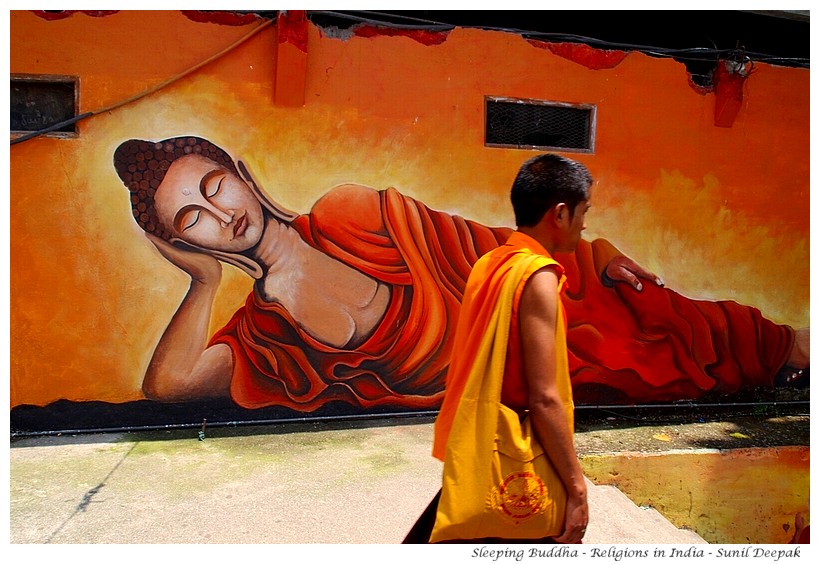
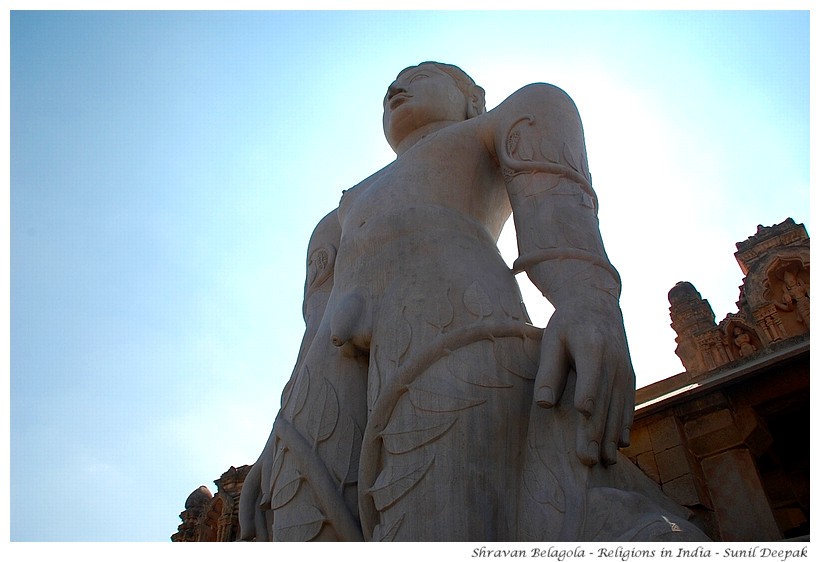
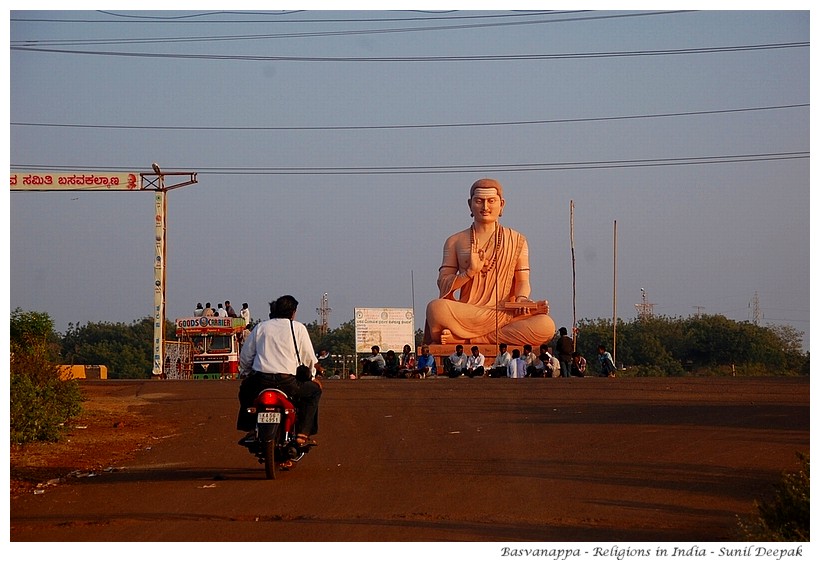
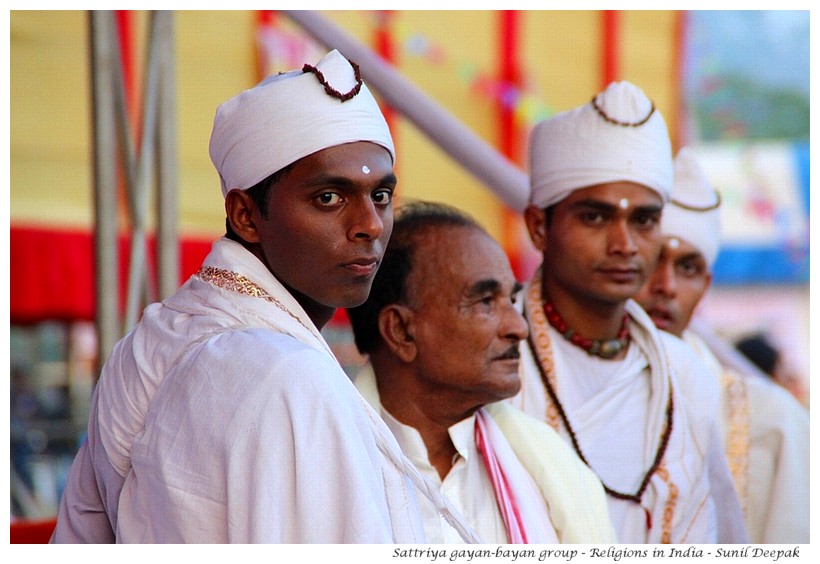
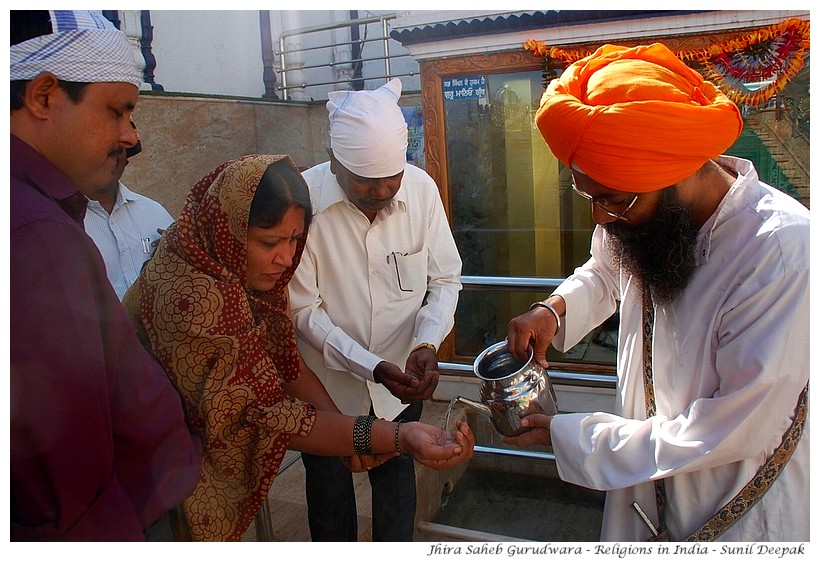
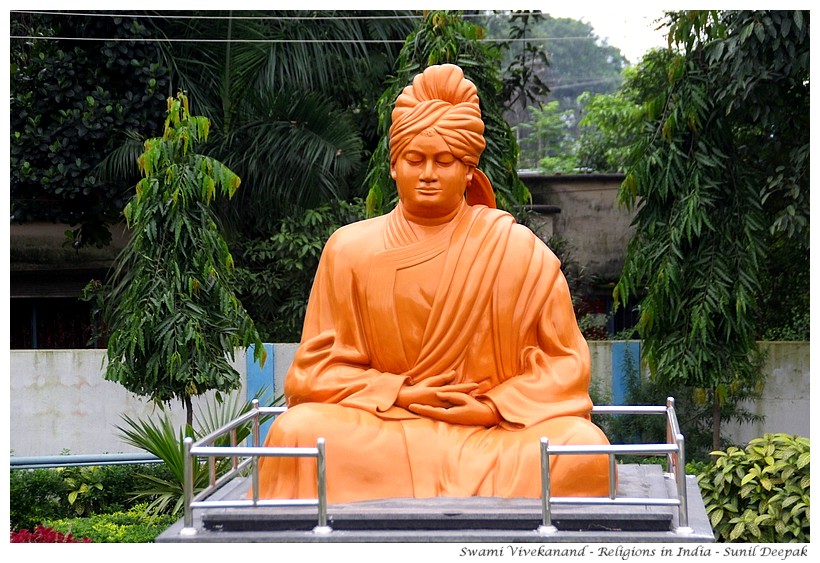
Religious ideas from other parts of the world
From ancient times, India has been the land of mixing and assimilation of religions, beliefs and cultures.
Over the centuries persecuted people from around the world, such as Jews, Armenians, Parsi (followers of Zarathustra) and Baha’i (followers of Bahai’ullah), came to settle in India, conserving their religious identities and ideas, even while exchanging some ideas with the Indic ideas of sacred.
Wandering mystics, explorers and conquering armies have brought other religious ideas to India including those of Islam and Christianity. Like other arrivals before them, India promotes both conservation of identities and ideas, as well as their inter-mixing with Indic ideas of sacred, thus giving birth to new identities and ideas.
The first ideas of Christianity came to southern coast of India with St. Thomas, more than two thousand years ago, even before there was a Vatican. Colonialism and globalisation in the past centuries have brought different streams of Christianity to India. Thus, while Christians constitute only 2% of Indian population, they are a majority in some states of India and have a strong influence in society through their schools, hospitals and programmes of social development.
I am presenting four of my images about Christianity in India. The first image is of a church in Bidar district in Karnataka. While the priests have a saffron shawl on their shoulders (saffron is traditionally the colour of Hindu ascetics in India), and sit on the floor, the church wall carries symbols of all the different religions.
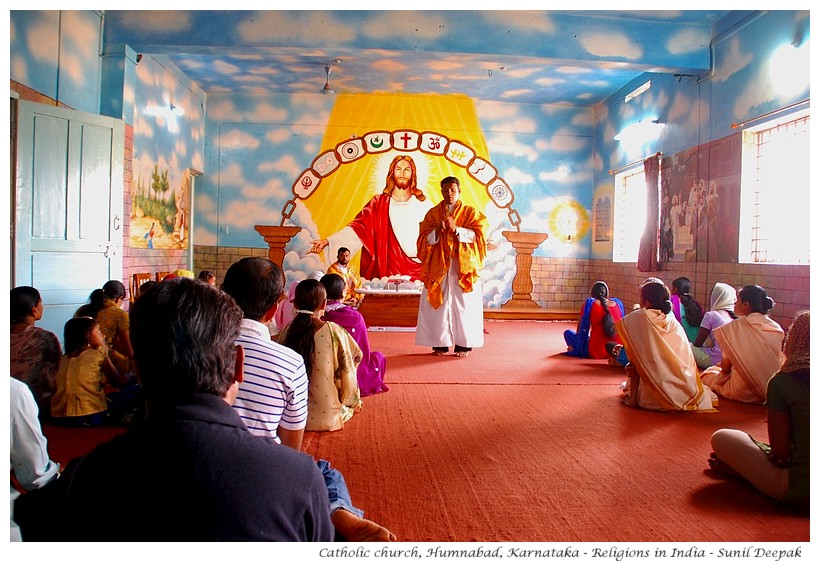
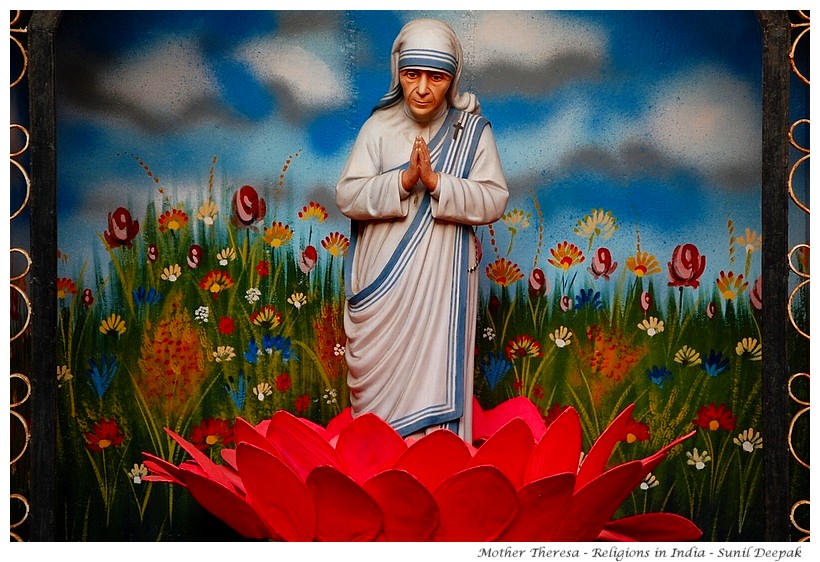
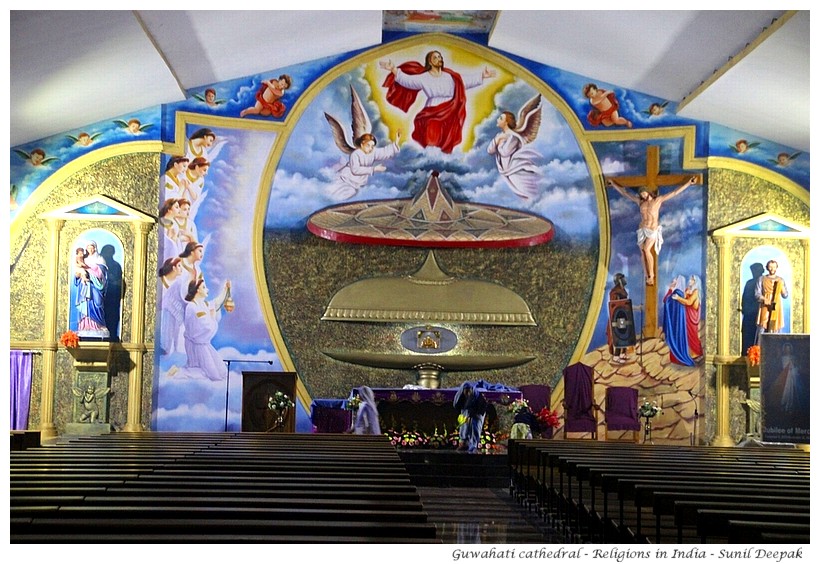
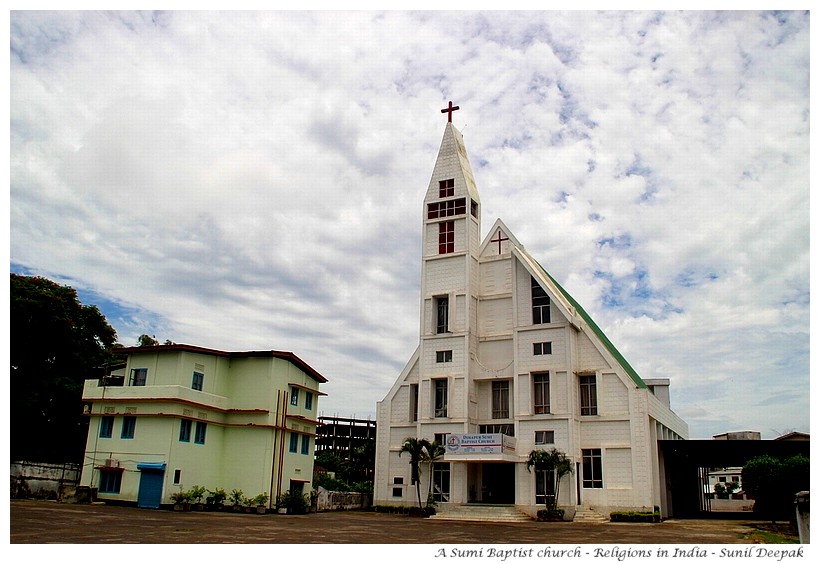
One important icon of Hindu-Muslim inter-mixing is Bhakt Rahim from 16th century India, who was a minister in the court of Mughal emperor Akbar and at the same time, a writer fluent in Turkish, Persian, Sanskrit and Braj bhasha. Thus while he translated Babarnama, the autobiography of Mughal emperor Babar, from Turkish to Persian, he is also considered a part of Indic social reformers for his devotional dohas (couplets) in Braj bhasha. In these prayers, he used Hindu religious imagery to express himself. For example, look at following doha of Rahim where is uses the word "Hari" to talk about God:
Rahiman gali hai sakri, dujo nahi thaharai
Apu aahai to Hari nahi, Hari to aapun nahin
(Rahim, the street is narrow and two persons can’t pass it together; if I will go inside God cannot, if God enters it, I cannot).
The last three images of this photo-essay are about Islam. The first image shows a group of Hindu labourers working in Char Minar, a Muslim building in Hyderabad in Andhra Pradesh. Built by Mohammed Qutb Shah in 1591 to commemorate the end of plague, the ground floor of this building hosts both a mosque and a temple. Similarly, for many Hindu festivals, traditionally the icons are made by Muslim craftsmen.
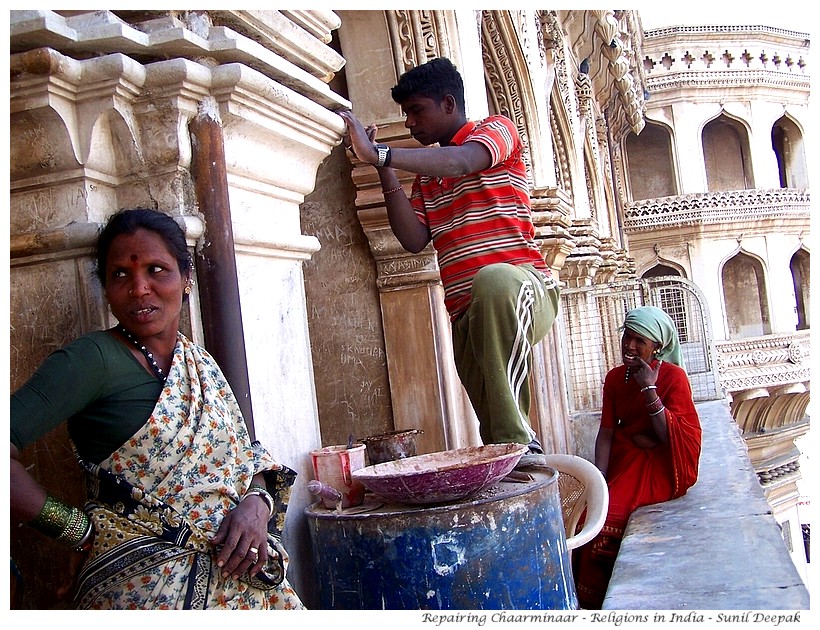
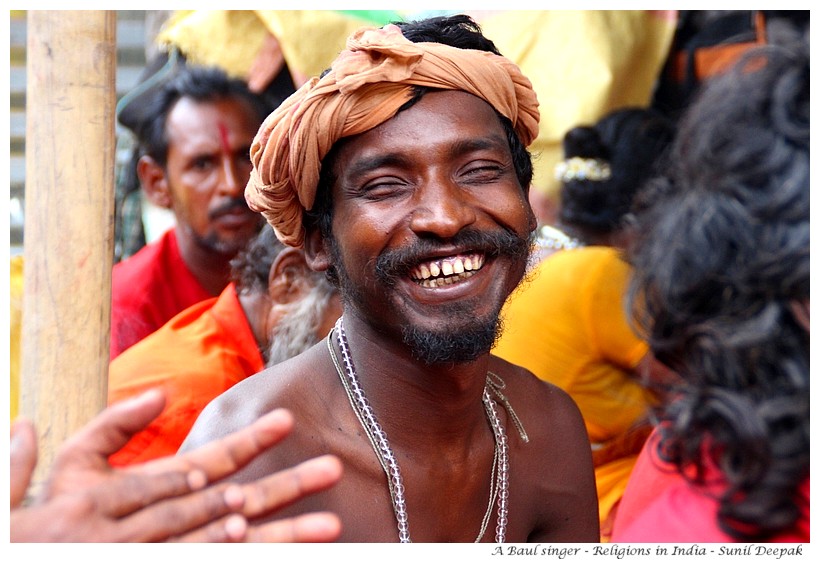
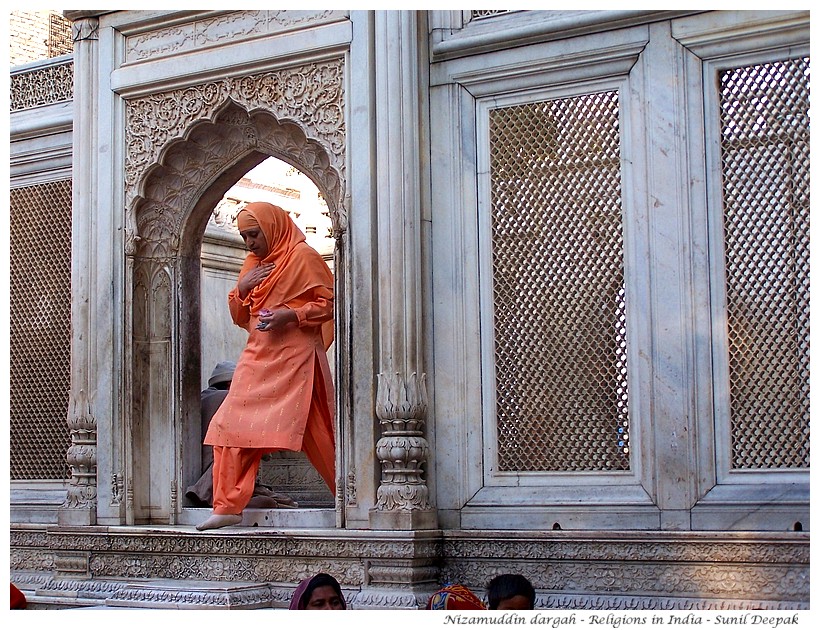
Valuing Inter-mixing of Religions in India
A closer look into religious beliefs in India, shows that often, the inter-mixing and blurred boundaries between the religions are more important than the perceived differences. By promoting inter-mixing, we promote understanding and love between people of different religions.
The world today is full of examples of religious hate and misunderstandings. To overcome these divisions, the approach chosen by many countries and persons is that of "respect and tolerance" along with political correctness. The basic idea of this approach is that the religions are different and we should avoid hurting the religious sentiments of others. Therefore, these countries propose to not to put up Christmas trees so as to not offend the non-Christians; they suggest to use words like "Seasons greetings" rather than "Idd greetings", so as to not to offend non-Muslims.
I personally feel that such an approach makes all of us poorer. I prefer the Indian way where we all celebrate all the festivals of all the religions, where we can pray in each other’s praying places, without losing our own cultural and religious identities.
People who believe in the separateness of their religions, they are afraid of such an approach of inter-mixing. India shows that you can still be a Hindu, Muslim, Christian or Sikh, even if you share the religious and sacred ideas, foods and festivals of others.
For this reason, I believe that in India we must learn to value our inter-mixing approach. One way to do it will be by recognising those of us who are mixtures of linguistic, regional, castes and religious identities. For example, I feel that the national census in India should collect information about the different ways we intermix and the number of mixed families in the country.
Religious fundamentalists oppose inter-mixing of religions, Indian approach teaches us to promote it. Children of the mixed families who will have the freedom to choose their religions, will be the ambassadors of inter-religious peace.
Another way to support inter-mixing of religions in India can be by recognising as valuable all those celebrities who are widely known and admired and who are part of inter-religious or inter-caste marriages. For example, Bollywood stars with their multi-religious families, from Sunil Dutt-Nargis and Kishore Kumar-Madhubala, to Shahrukh-Gauri and Saif-Kareena, are examples of religious inter-mixing and joyful co-living not only for India but for the whole world. In a deeply divided world, they are our icons of unity, without losing our individual religious and cultural identities.
Your prayer for India
So to come back to my original question - if you could write just one prayer for India, which kind of prayer would it be?
Will it have different Gods including Ishwar and Allah? Will it be about different prophets such as Buddha, Mohammed, Jesus, Nanak, Mahavir, Zaruthustra and Bahai’ullah? Will it be about different paths leading to one Parmeshwar?
I hope that you will answer yes. I hope you will ask for the one life-force that underlies everything organic and inorganic in the cosmos. I hope that it will be a prayer that will promote peace, love and harmony.
***
Wednesday, 2 January 2013
Religions For The New Millennium
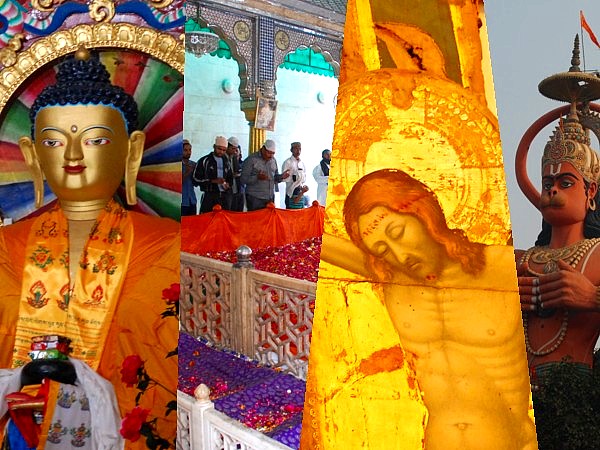
These are the questions I often ask my self, while thinking of the situation of religions today. We have two contrasting situations:
- We have more inter-religious dialogue and harmony among persons of different religions than ever before in history of mankind.
- There are increasing number of radicalized and exclusionist religious groups seem to be getting stronger, who insist, often with violence, that their way is the only acceptable way. This group is dominated by Islamic radicals.
Religions of the prehistorical humans
Our earliest progenitor, Homo habilis, who used stone tools, came out more than 2 million years ago, but modern humans developed only around 50-60 thousand years ago. One of the earliest records of those first humans are the rock paintings, like the ones in El Castillo in Spain that are 40 thousand years old.The El Castillo rock paintings mainly show animals on the cave walls. This was the Paleolithic (initial stone age) phase of human development. Thus at that time human beings were using simple stone tools, they did not have writing, yet they had good drawing abilities and had spiritual ideas about the world. More recent caves, from the early bronze period of human development also include stick like human figures.
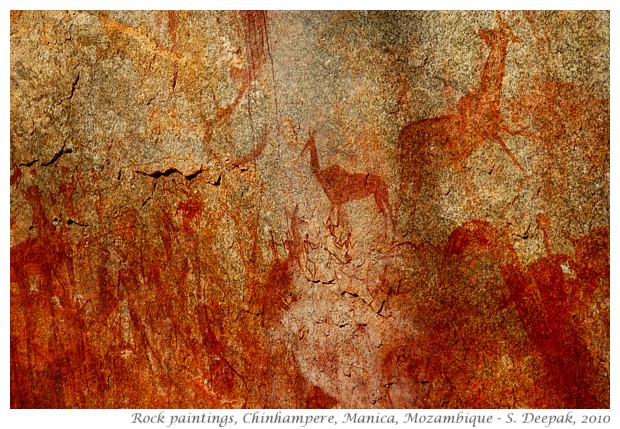
These rock paintings point towards the religious or spiritual ideas of humans who lived as hunter-gatherers. Animal rock paintings have been linked to influencing the spirits of animals, to facilitate their hunting.
Religions at the beginning of historical era
The beginning of historical era, started around 4 to 5 thousand b.c. (6 to 7 thousand years ago), as the first cities and civilizations came up in different parts of the world including Egypt, Mesopotamia, China, India and Greece. All the different world cultures at that time had started building specific praying places and all of them included a pantheon of gods.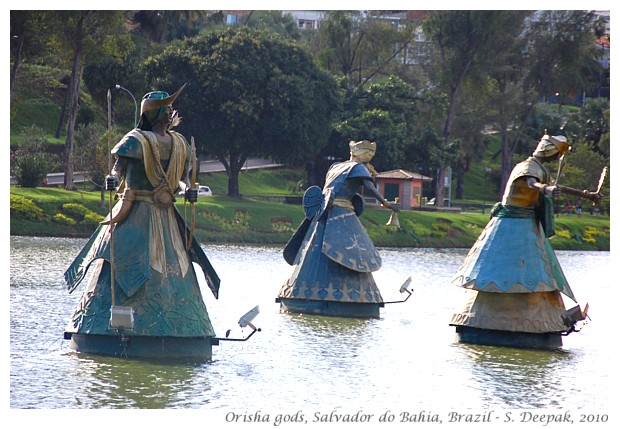
James A. Michener in his book "The source" (1965) traced the development of different religions in middle east, from the beginning of the historical era till today. In a fictionalized form, he explains the transformation from hunter-gatherers to farmers:
.. for the first fifteen years of their married life, Ur's wife went out of the cave in all seasons trying fruitlessly to tame the wild wheat, but each year it was killed either by drought or flood or too much winter or by wild boars rampaging through the field ... Ur's son discovered that the springtime planting of wheat need not be left to the chance scatter of autumn grains. By holding back some of the harvest and keeping it dry in a pouch of deerskin, the grains could be planted purposefully in the spring and the wheat could be made to grow exactly where and when it was needed, and with this discovery the family of Ur moved to a self-sufficient society.Farming communities living in the villages were much more vulnerable to nature's forces such as rains, lightening, thunder storms and fires. These farming humans developed religions with pantheon of gods - a different god for each of the nature's forces that affected their lives. Thus in the pantheon of gods, those who controlled rain, fire and the thunder storms were more important for the farmers.
For example, India's first sacred book Rigveda, written around 1500 BC, puts into writing the oral traditions of religious prayers that had developed in this early historical period. The most powerful gods of Rigveda, to whom maximum number of prayer-hymns are devoted, are Indra, the god of rain, and Agni, the god of fire.
As human beings developed greater understanding and control of agriculture and they developed new technologies such as boats for sea-travel, new gods became more important and older gods were forgotten.
The mythical Indian story of fight between rain-god Indra and pastor-god Krishna, where Indra brought incessant rains and Krishna protected the pastors by raising up the Govardhan mountain on his hand, is one such example of changing religious ideas as small cities came up and needs of protection from gods changed.
Another Indian example of changes in preferences of gods is about worship of Sheetla mata, the goddess who is supposed to protect children from diseases like small pox and chicken pox. You can still find temples of Sheetla mata in poor slum areas where diseases like chicken pox and measles continue to be a life-threatening problem for poor children, but such temples are rare in urban and more developed areas of India.
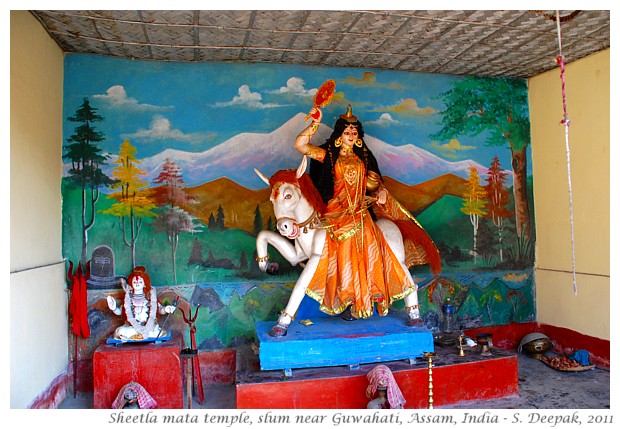
The rise of monotheistic religious thought
Building of praying places and offering prayers, gifts and sacrifices also gave rise to development of priests-classes, with possibilities of conflict between followers of different gods, and between priests and others. For example there is the story of Ikhnaton, the "heretic king" in ancient Egypt, who revolted against the domination of priests of Amon and decided to pray to the Aton (sun god), is one such example of religious conflicts.In situations of conflict, religious reformers appeared in different parts of the world. Some of them proposed the vision of "one God", a supreme force that controlled life. The period around 500 BC to 500 AD was particularly fertile for these spiritual reformers, especially in two specific geographical areas of the world - the western part of middle-east and northern-part of Indian subcontinent. Those reformers were responsible for most of the religious ideas that dominate the world today.
The middle-east saw figures like Moses, Jesus and Mohammed, who expounded on ideas of the "one God". In the Indian subcontinent, apart from figures of Mahavira and Buddha, there were other philosophers whose ideas formed the Upanishads of Hinduism. These also tend towards ideas of monotheism, though in a different way from the monotheistic ideas that developed in the middle east.
In all religious traditions, a cycle of periodic rise of new religious reformers started that continues till today. Sometimes, the reformers resulted in groups breaking off from the parent religions and becoming separate religions in their own right. At the same time, there continue to be small or large groups of persons who believe in older religious ideas of early farmers and pastors, such as fire-worshipers (Zoroastrians), nature worshipers, believers of the spirit worlds.
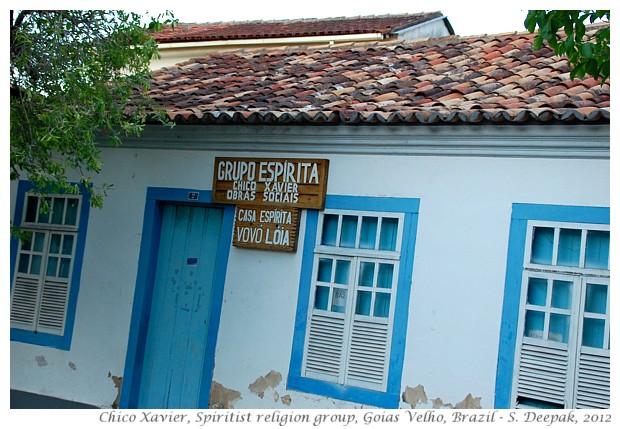
The crisis of the religions
4-5 hundred years ago cities became bigger and the technological innovations increased. Invention of printing press, colonization, slave trade, large scale immigration towards the "new world", scientific progress and industrial revolution gradually started challenging the existing religious ideas.For example, in Europe, different developments such as discovery of fossils, Darwin's theory of evolution, Galileo's ideas of earth and planets circling the Sun, challenged some of the beliefs proposed by Christian theologians. These challenges resulted in ferocious religious backlash by Christian conservatives in Europe including centuries of brutal inquisition and religious crusades.
One of the most important change that is challenging traditional ideas of religions is the shift from rural to urban communities. This shift challenges the hold of religious, community and family leaders on individuals. Thus, in urbanized countries, earlier religious ideas and socially acceptable behaviours about everything including marriage, having children, sex (including same sex relationships), dresses and worship, have been overturned.
Though this transition of old into new communities started in Europe more than 5 hundred years ago, it is still far from over. For example, Michael S. Kimmel discusses the challenges for men to understand the new roles of gender equity in his paper:
Indeed, the women’s movement is one of the great success stories of the twentieth century, perhaps of any century. ... Today, this movement for women’s equality remains stymied, stalled. Women continue to experience discrimination in the public sphere. ... I believe the reason the movement for women’s equality remains only a partial victory has to do with men. In every arena—in politics, the military, the workplace, professions and education—the single greatest obstacle to women’s equality is the behaviours and attitudes of men. I believe that changes among men represent the next phase of the movement for women’s equality—that changes among men are vital if women are to achieve full equality. Men must come to see that gender equality is in their interest—as men.If that is the situation in the developed world in Europe and America, what is happening in the rest of the world? The changes have become faster and even more radical over the past century, spreading over to all the different parts of the world. Improvements in health care and birth control, women going out of homes to work, access to education, international travel, globalization, information technology are some of these changes that lead to mixing of populations and ideas. These changes are challenging traditional ideas of different religions and the social roles of men and women.
Religions for the future
Shall we really need religions in the future? I personally feel that as long as there will be questions such as: what is life, what is death, is there an afterlife - there will be a space for religions.There are many persons who do not believe in a spirit or a cosmic consciousness, who define themselves as atheists, but often even they have some doubts in explaining the godless accidental origin of life from a biochemical primordial soup.
Those of us who live in societies where technical progress safeguards us from the worst of nature's forces, people do not need to seek the protection of gods for their survival. Still illness, accidents, stresses of modern life, and relative poverty create fertile groups for prayers, spirituality and may be religions.
Individuals living in resource and technology rich environments already often have religious ideas that have been called "New Age". An explanation of the "new age" philosophy is as follows:
To understand New Age philosophy it’s important to understand that the contemporary Cosmic Humanist movement has its roots in the Romantic poets of the 1800s, such as Ralph Waldo Emerson, Walt Whitman, and Henry David Thoreau. These men rejected the God of the Bible, instead writing at length about a transcendent quality of spirituality experienced purely through personal introspection. These ideas did not attract a broad audience until the 1960s, when popular recording artists, movie stars, and Eastern gurus began trumpeting their New Age views across the nation. More recently, well-known recording artists such as Madonna and Alanis Morissette have identified themselves with Hinduism, while popular personalities such as Tiger Woods, Phil Jackson, and Richard Gere openly embrace Zen Buddhism. Other luminaries, such as Tom Cruise and John Travolta, express a belief in scientology.We don't know if future religions will be shaped by these "New Age" ideas or other different ideas. However, to be acceptable to majority of people, religions will have to take into account the needs of persons living in urban spaces as singles or as nuclear families. Thus the ancient ideas of women's and men's roles will have to change.
For example, in my opinion, religions asking for covering of women's bodies or not letting them go out to work or with rigid ideas about what kind of sexual lives people should lead, will not be accepted in future as societies will change and people get used to living in urban spaces.
Personally, I also believe that future religions that do not take into account the principles of universal declaration of human rights, will be refused by majority of world population. Such conservative religious groups and sects may continue to flourish in small minority communities, but they will not become mainstream.
Thursday, 1 November 2012
Colonization of Minds
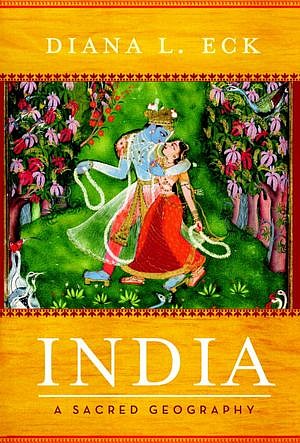
Thus I discovered some Indian myths and stories that I had not heard about before. For example, ancient Indians believed that a mountain called Meru was the centre of the world. This Meru or golden mountain has eternal light and is connected to the polar star. It is un upside down mountain, narrow at the base and wide at the top. At its top are homes of the gods, especially the homes of Brahma and Shiva. The celestial Ganga river falls from the heavens on top of Meru and then divides into four rivers and goes in four directions, including Alaknanda going towards India. All the four Ganga rivers are equally holy. There are 4 continents, shaped are like four petals of a lotus flower around the Meru mountain and the southern petal is Jambudwip or Bharatavarsha (India).
Diana Eke explains in great detail these ancient beliefs and describes how this conception of the world was completely different from the world conception of other ancient civilizations:
Since Meru is king of the mountains in a confluence of mountain ranges that is the most awesome on earth, it is all the more arresting that Hindus do not derive their symbolic image of Meru from the great granite and ice peaks of Himalayas. Rather it comes from the living, organic world of flowers. Meru is the "seed cup" (Karnika) of the lotus of the world." ...
Bharata is the southernmost land of this lotus world. India's imaginative world map does not place India directly in the centre of the world as did Anaximander when he drew the first world map with Greece in the centre, or the medieval cartographers when they placed Jerusalem and the holy Land in the centre, with continents spreading forth like petals. Rather Bharata is but one of of the petal continents. In many ways it is the least glorious. Far from the usual ethnocentrism in which one's own world is described as civilized, while the surrounding lands, vaguely known, are thought to be less so, even barbarian, the Indian visionaries who described the world actually idealized the other petals of the world ...
Why don't the Indian school books say anything about ancient Indian traditions?
While I was reading this part, I was thinking that I am close to sixty years and this is the first time that I am reading about the worldview of the ancient Indians and about India's place in its geography. I felt a little cheated that our schools or colleges did not talk of these myths of ancient Indians and how these could have shaped our present world views and our ways of thinking?I am not saying that we have to teach to school children that this is the geography of the world or that we should not teach them about modern geography. Conservative Christian groups in USA or conservative Islamists in different parts of the world or even Hindutava groups in India have those kind of ideas where they want that school children be taught what is written in ancient religious books, and not what the modern science has taught us. I do not agree with those ideas.
Rather, I am thinking that while we learn the modern geography and science, we should also learn about the ancient Indians myths and stories. Not as blind beliefs, but we should learn to look at them critically. This is needed to understand how these beliefs were different or similar from the beliefs of other ancient cultures, and how these could have shaped the development of Indian society.
A cultural understanding of societies
I think that societies have a cultural understanding of who they are and how to came to be the way they are. These cultural understandings are different for different cultures. In my view, ignoring or forgetting these cultural understandings is ignoring an important aspect of ourselves. We need to look at these cultural understandings in a critical way, to appreciate them, to value them, to recognise how they have contributed to the development of our societies.This does not mean that we have to take them as the absolute truth, but it also means that they should not be devalued and forgotten. I am arguing for a middle way between the extremes of strident Hindutva and the denying-the-religions kind of secularism?
I agree that these ancient beliefs are Brahmanic beliefs. For centuries these beliefs have excluded large sections of Indian society, especially those who are considered "low castes" and tribal groups. Thus I am not saying that these are the "only" beliefs of ancient Indians. Yet given their pervasiveness in significant parts of Indians, these can not be wished away.
I also believe that parts of these ancient beliefs need to be changed. For example, Hindu scriptures propose a particular role for women and girls and they espouse a particular role for those they call as "low castes" and ask for their exclusion and exploitation. I don't think that respecting our myths and ancient stories means accepting these aspects of our culture as right. Rather, I believe that we need to change with times and look critically at how we deal with issues like dignity of individuals and dignity of labour and change our societies. But to criticise aspects of scriptures or to ask for change, does not mean that we hide or ignore parts of our history and traditions.
In a way, I feel that persons asking for Hindutva are actually blind to Hinduism's pluralistic traditions and tend to look at religion and culture through linear-rational way of thinking where they dream of homogenizing Hinduism, like a parody of monotheistic religions. Thus while they talk of saving Hinduism, in reality they work for destroying it.
Western "linear-rational" and Indian "non-linear, apparently contradictory" ways of thinking
The past few centuries have seen the rise and domination of western way of thinking that is linear-rational way of thinking. It has brought great progress in the world including science, technology and even the modern ideas of human rights and equality of human beings. This western way of linear-rational thinking is important for all of us as part of our education, science, industry, etc.On the other hand, traditional Indian way of thinking is non-linear, multi-directional and apparently contradictory. In his book "Nine Lives - In search of the sacred in modern India", William Dalrymple has described an interview with a sculptor from Tamil Nadu, where he brings out this non-linear and apparently contradictory way of reasoning:
It seemed to me that Srikanda had mentioned three quite different ways in which an inanimate statue could become a god: via the channelling of divinity via the heart and hands of the sculptor; a ceremony of invocation when the eyes were chipped open; and through the faith of the devotee. I pointed this out to Srikanda, but he saw no contradictions; all that mattered was that at a certain point a miracle took place and the statue he had made became divine.Sometimes, this non-linear and contradictory way of thinking confuses western students of Hinduism and Indian culture. Such confusion is also apparent in relation to philosophies of other oriental religions including Buddhism, Jainism, Sikhism, etc.
For example, I remember some discussions with friends of other religions where they felt that because of multitude of gods and goddesses and because of idol worshipping, Hinduism is in some way inferior to their ideas of one god, or at best, it is is an illogical way of thinking. I think that they look at Hinduism in a linear-rational way of thinking and can not appreciate the Indian non-linear way of understanding the world that feels that "this and its opposite, both can be true".
Should this non-linear and contradictory way of thinking be considered inferior or should be ignored and forgotten?
I also believe that the Indian ways of thinking has its own value. For example in the way we traditionally deal with nature. From ants and mice to owls and peacocks, ancient Indian beliefs look at insects, birds, plants and animals as sacred. This can be seen as superstitious or illogical by the western thought. However, looking at birds or plants as sacred, can also be seen as respecting the world and creating a harmonious relationship between humans and nature.
Breaking out of cultural colonization of minds
I feel that we have a kind of cultural colonization of our minds, where we pretend that only western linear-rational way of thinking exists, and world needs to be understood exclusively according to this logic. The non-linear and apparently contradictory thinking pervades our cultures, but we pretend that it does not merit acknowledgement or understanding.We need to break free of this cultural colonization and learn to look at our ancient myths, stories and traditions as living paradigms that influence and shape us even today.
For example, I would like to learn about how the ancient Hindu myths were translated in Jain and Buddhist traditions? Did they influence early Christianity when it came to Kerala with St Thomas, two thousand years ago? Did they have an influence on Muslim-Sufi and Sikh philosophies? Did they shape the way Indians look at the world today?
***
Thursday, 19 April 2012
Hindu, Muslim, Sikh, Issai - Inter-Religious Bollywood
Multi-religious societies & Cinema
I think that among all the different films made in different parts of the world, Bollywood and Indian cinema have touched on the issue of inter-religious connections many more times, compared to the rest of the world. May be it has something to do with the way Indians perceive themselves?Almost all the countries of the world today are multi-religious. However, most of them do not think of themselves as multi-religious. Or rather did not think of themselves as multi-religious till recently. On the other hand in India, we think of ourselves as being part of a multi-religious country for a long time. May be it is because of our history. It may be also because many religions started in India.
In India 80% of the population is Hindu, though Hinduism can be interpreted very differently among different groups of people in different parts of India, and remaining 20% is composed of different religions. In US, about 75% of population is Christian (protestants and Catholics), while the remaining 25% belong to different religions, including those who do not believe in any religion. In UK about 70% of the population considers themselves as Christians. In Italy, 80% of the population identifies itself as Catholic. So more or less, all these countries have similar percentages of majority groups and minority groups.
Yet, in my opinion, the awareness about different religions and their beliefs, is much higher in India than any where else. Could that be the reason why Bollywood has been extra-sensitive to the issue of inter-religious relationships?
If I think of films from any other country - USA, France, Italy, Japan, Korea, China ... I can't remember even one film on the subject of inter-religious relationships. Even when their films have characters from other countries/religions, usually they are shown in a way where religious differences are not an issue. However, I have seen some American documentary films on this subject, specially on the issue of inter-religious marriages between Christians and Jews.
Mixed Religion families in Bollywood Films
While the more popular Bollywood films used characters of different religions in close family and friendship relationships, they also maintain clear boundaries between them. Thus, in most of these films, Muslims are always married to Muslims, Christians to Christians and Hindus to Hindus.However, the idea of mixing up of religions in the Bollywood families has been touched upon many times. When I think of significant Bollywood films that have touched on theme of inter-religious families I think of four films - Dharamputra, Amar Akbar Anthony, Zakhm and Bombay.
Dharamputra (1961): This Yash Chopra film was my introduction to a world united and yet divided because of religions. It was about a Muslim girl (Mala Sinha) who has to give away her son, born before her marriage, to a Hindu couple who are her family friends (Manmohan Krishen and Nirupa Roy). Years later, that son (Shashi Kapoor) grows up into a Hindu fanatic and during the partition riots goes to burn the house of his Muslim mother.
Amar, Akbar, Anthony (1977): This Manmohan Desai film is another old favourite about three brothers who get separated when they are young, and grow up in three different families beloning to three different religions - Amar (Vinod Khanna) grows up as Hindu, Akbar (Rishi Kapoor) grows up as a Muslim and Anthony (Amitabh Bacchan) grows up as Christian. One of its most celebrated scene had blood transfusion tubes running from the arms of the three brothers and going into the arm of a blind woman (Nirupa Roy) who is actually their mother, but they don't know it.
The film looked at religious differences as being important for the individuals and yet almost unimportant for the relationships among people. The three brothers growing up with different religions, are shown to be in love with girls from their own religions. They are shown living in the worlds made of persons of their own religions. The film never discusses the impact of religious differences but rather seems to take it for granted that the persons from different religions would love each other "because they are brothers".
There are no religious fanatics or any speeches about religions in this film. Thus, I see this film as an allegory for the ideal multi-religious India, where each religion can maintain its distinctiveness, its own costumes, and yet be like a family.
Zakhm (1998): This is one of the my favourite films of all times. Directed by Mahesh Bhatt, this was an autobiographical film. Against the backdrop of religious riots in Bombay, the film tells the story of an old woman (Pooja Bhatt), who has been burned alive by a Muslim guy. As she struggles for her life in the intensive care unit of a hospital, her younger son, with the help of Hindu hardliners would like to take a revenge on the Muslims. Her elder son (Ajay Devgan) tells the story of their family to his younger borther.
It is the story of a Muslim woman in love with a Hindu film director, who dies in an accident leaving her with two sons. She hides her own faith and brings up her two sons as Hindus, even though she is rejected by her husband's family.
The film had a powerful performance by child actor Kunal Khemu as the elder son, during the parts in flash back, where Ajay tells about his childhood.
In South Asia, the boundaries between religions can often be hazy. Many families carry hidden histories of inter-mixing of different religions. I felt that this film brought out the issue of those hidden histories in a powerful way. It was also a strong voice against the fanatics and the hate-mongers of different hues.
Bombay: This 1995 film by Mani Ratnam is one of those rare films that touched on a vital question in all inter-religious marriages - the question of the religion of their children. The Hindu-Muslim couple in the film opt for a civil marriage and ignore the religions.
However, their two fathers would like that their grandchildren follow the family religion. The couple has twins and thus, the two grandfathers decide that one grandchild can receive Muslim religious knowledge and the other can be Hindu. Only when there are Hindu-Muslim riots that threaten the lives of the two children, it makes them understand the futility of religious fights.
Many mixed-religions couples today are like the couple of this story, who do not feel very religious and who feel that they can continue to follow different faiths. However, the issue of their children's religions is a thorny one, especially when there are family expectations and pressures from the two sides.
The different ways in which families deal with this issue, I think that it needs to be tackled in more films.
Conclusions
Bollywood-world often shows persons of different religions, living together as close family friends or relating to each other in positive ways.In a way it is a reflection of the Indian society and at the same time, I believe that it strengthens knowledge and relationships between people of different religions in India.
There are many examples of mixed-religions families in Bollywood cinema. Personally, I believe that in this direction, Bollywood (and Indian cinema in other languages) has been much ahead of all other cinematic traditions in the world.
***
This article is part of my reflections for an email based research on mixed religious couples and families. This research is called "Mixed Doubles: You, I and our Gods".
***
Thursday, 28 July 2011
Playing Dead in a Cemetery
Virginia's Idea
For that art-installation, I only needed to look dead in some pictures and I had to share my ideas about the question: "what do you think happens when we die?".
Certosa Cemetery of Bologna
I love Certosa (the initial "C" is pronounced like the "ch" in church) cemetery. It has been a burying place for the dead for more than two thousand years. First it was an Etruscan cemetery, and then a Roman cemetery, and then over the past fifteen hundred years, as Bologna changed from a settlement and assumed the form of a city, Certosa has slowly grown bigger.In the medieval period (1300-1500 DC), people started making monumental graves with sculptures in the Certosa Cemetery. Therefore, many areas of Certosa are like an open air museum, with hundreds of statues. The most common theme in this museum, as you can guess, is bereavement, with statues evoking feelings of loss, sadness and crying. However, there are many statues on the tombs of big and famous persons, that are more about power, wealth and vanity.
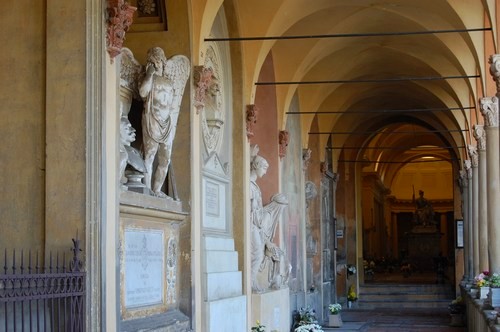
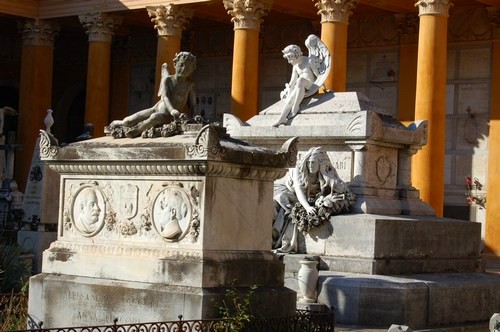
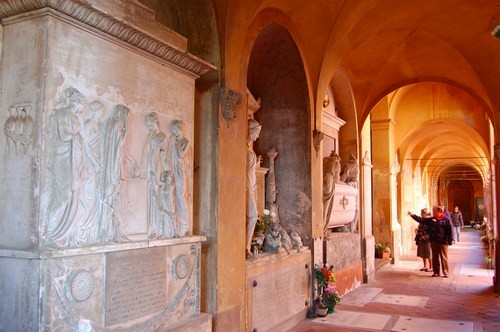
Surrounded by verdant hills, some parts of this cemetery have lovely views. Over the last two decades, cremation rather than putting the dead persons in graves, has also become more common. They even have an open grassland, where those who do not wish for a grave or an urn, can scatter the ashes.
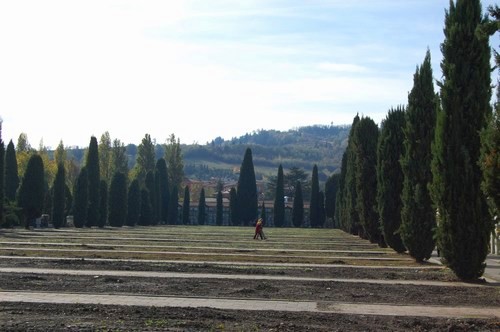
In today's culture, where emphasis is on enjoying life, normally people do not want to talk or think about death. It was not always like this. For example think of the huge tombs built by Egyptian kings for their own burial, because they were worried about their afterlife, and wanted to make sure that they could continue to live as kings after their death.
Talking About Death
Most of us have difficulties in talking about death and bereavement. Amitav Ghosh in a beautiful article about the death of his friend Agha Shahid had written in 2001:Although Shahid and I had talked a great deal over the last many
weeks, I had never before heard him touch on the subject of death. I did
not know how to respond: his voice was completely at odds with the content
of what he had just said, light to the point of jocularity. I mumbled
something innocuous: “No Shahid—of course not. You’ll be fine.” He
cut me short. In a tone of voice that was at once quizzical and direct, he
said: “When it happens I hope you’ll write something about me.”
I was shocked into silence and a long moment passed before I could
bring myself to say the things that people say on such occasions: “Shahid
you’ll be fine; you have to be strong …”
Shahid ignored my reassurances. He began to laugh and it was then
that I realized that he was dead serious. I understood that he was
entrusting me with a quite specific charge: he wanted me to remember
him not through the spoken recitatives of memory and friendship, but
through the written word. Shahid knew all too well that for those writers
for whom things become real only in the process of writing, there is an
inbuilt resistance to dealing with loss and bereavement. He knew that my
instincts would have led me to search for reasons to avoid writing about
his death: I would have told myself that I was not a poet; that our friendship
was of recent date; that there were many others who knew him much
better and would be writing from greater understanding and knowledge.
All this Shahid had guessed and he had decided to shut off those routes
while there was still time.
“You must write about me.”
We have an old dog and often I am worried that one day he will be gone. Also, when you cross fifty, I think that consciously or unconsciously, you begin to ask yourself, how many years you still have to live. So I think about death off and on for some time now.
I had visited Certosa many times and had already expressed my thoughts to my wife that when I die, I would like to be cremated and I would like my ashes to be scattered in the Certosa open grassland area. Therefore when Virginia asked me to be part of her art installation on death, I didn't think twice and immediately agreed. However, some of my friends were not so sure if it was a good idea.
"Won't it be inauspicious to have your picture there while living? It is only dead persons' pictures that are put there?", they worried.
I looked at it differently. "How many of us get a chance to see our own pictures as dead? How many of us get to see our pictures displayed in a cemetery? No one. So if I have this opportunity, I don't want to miss it."
Virginia had a special technique for taking pictures, so that it looked as if the person was coming out of darkness. She took pictures both with persons' eyes open and with eyes closed. "I won't take off my glasses", was my only condition. I know that dead don't need eye glasses, but what fun is to play dead, when no one recognises your picture because you are without your glasses?
My Ideas About Death
I also spoke to Virginia about my views about death, influenced mainly by Hinduism, though not in the sense of paradise or hell:I like the way death is described in Kenopanishad and Kathopanishad. I think that everything in the universe is pervaded by the same consciousness, and when we die, our individual consciousness goes back to all pervading consciousness, like a river goes in to the ocean. That all mountains, plants, animals and humans are inter-connected through this consciousness.Virginia recorded my views in Hindi also.
I think that everything in this physical universe is made of molecules, atoms and sub-atomic particles and these particles are exactly the same in every thing. Thus, all persons, animals, birds, plants, rocks are made of same building blocks, but our level of consciousness energy is different.
I like the understanding coming from quantum physics that at sub-atomic level, a particle can be in many places at the same time and that between the particles there are huge spaces, so much that relatively, the distances between the constantly dancing sub-atomic particles inside each atom that compose us, are like the distances between the planets. Therefore, each particle of our bodies, is like a solar system. I think that this describes the concept of Maya that Upanishads talk about.
The Art Installation in Certosa
The art installation was set up in an underground hall from 14th century in the cemetery. Along the 700 hundred year old tombs, she had placed our images on the walls. We were 12 persons representing 12 different religions and cultures. We all spoke our views about death in our languages. So people, while looking at our "dead" pictures, could also read our views about death.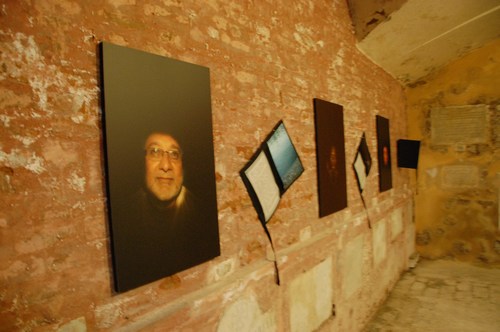
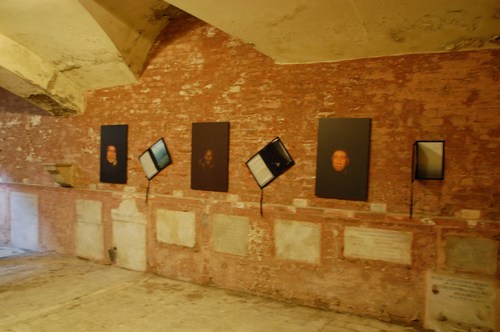
It was a wonderful sensorial experience. And, there was enormous diversity in our views about death. Virginia says that this multi-media art work was very inspiring for her. Now she is planning to involve even more persons and one day come out with a book about it.
Are you comfortable talking about death? What do you think happens when we die? Do you believe in reincarnation? Would you accept to be part of an exhibition, where you are shown as dead?
***
Friday, 1 October 2010
God of Goldilocks
This week's Astrophysics journal has the story of a planet going around a red dwarf star, 20 light-years away from the earth.The planet has been given the name "Gliese 581g", and someone with lot of imagination, has converted the final and unimaginative "g" of the name into "Goldilocks".
Goldilocks is the name given to those planets which are suitable for hosting life.
It seems that Goldilocks can be a planet suitable for life similar to our earth, it has the "the right size and location for life". May be all those scientists can take a break and need not worry about finding proofs of life on Goldilocks, I can already confirm it. There is life and there is God on Goldilocks, I know it.
Life is an Integral Part of Matter
I think that life is an integral part of all matter, that everything which has molecules, atoms and sub-atomic particles has life in it. However, we can't appreciate that life. We have a specific definition of life, which requires a certain threshold level of energy consumption, only then we call them alive.
Let me try to explain my view.
Scientists have already found that all matter is made of sub-atomic particles, that are in constant motion. Between our world as we see it and the sub-atomic world, there is such an immense distance that human imagination is not enough to understand it. In CERN near Geneva in Switzerland, scientists are trying to break down the sub-atomic particles to find out their compositions. I believe that sub-atmoic particles are made of ultra-sub-atomic particles, and distance of proportions between two groups of particles is as big or may be bigger than the distances between our world and that of sub-atomic particles.
In the same way, I believe that we are the sub-atomic particles of the universe, and may be our universe is sub-atomic particle for other bigger universes. For me, life is the constant motion of the sub-atomic particles, that is such that according to quantum physics it can be in more than one place at the same time. This life force joins all of us, humans, animals, plants, mountains, rivers, oceans, space, planets, galaxies into one. This super-consciousness is God.
It is for this reason that I like the ancient human's ideas of gods like mythical creatures, humans and demons and animals all combined like the mythical creatures on the Buddhist temples in Vietnam, like Ganesh in India, because these give an idea of unity of life beyond the apparent differences in our forms.
Scientists say that all our cells change, some die and others are born every minute, every day. Every time we breath, new atomic particles enter our bodies, mix with particles that make our body and some go out with our breath. We are being renewed all the time. Think of a being on Goldilocks, millions of years ago - its atomic particles mixed and travelled in space and have arrived on earth and have entered your breath. Goldilocks is here, inside you, inside us.
*****
This Year's Popular Posts
-
Before coming to Assam in the north-east of India, I had never thought of Shiva and Kali as a couple and I had also never thought of the two...
-
Note (2022) : I had written this post in 2006, to share my own ragging experiences. It is about my positive experiences of ragging in earl...
-
A visit to the Jan Jaati Sanghralaya (Tribal Museum) of Bhopal (Madhya Pradesh, India) brought back the memories of my childhood. If anyone...
-
This post has been published by me as a part of the Blog-a-Ton 22 ; the twenty-second edition of the online marathon of Bloggers; where w...
-
Last year I visited some beautiful places in Bundelkhand in central India. However, you won't find "Bundelkhand" on the map of...
-
A Scotsman, Robert Bruce is credited with the “discovery” of tea in Assam in India. I think that it is anachronistic that 70 years after the...
-
When suddenly you start noticing coincidences, does it mean something? Let me give you three examples of three recent coincidences, which ...
-
Recently I was reading the wonderful book Sapiens: A Brief History of Humankind by the Israeli writer Yuval Noah Harari (originally writte...
-
Finally I am ready to start with my Guwahati city walks – discovering this city through easy walking tours. For the first Guwahati tour I h...
-
" Why don't you make a film on the issue of disability and sexuality? ", I had asked Arun while we were out on a walk. After ...

.jpg)
.jpg)


.jpg)

.jpg)















